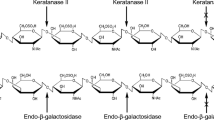Abstract
Cadherin molecules are known to be involved in various biological processes other than cell adhesion such as morphogenesis, cell–cell communication, cell recognition or cell signalling. While the classical cadherin molecule is characterized by an extracellular moiety, a transmembrane region and a variable cytoplasmic domain, T-/H-cadherin differs from this pattern due to the absence of a transmembrane region and a cytoplasmic domain, respectively. Its extracellular moiety is bound to the apical cell membrane by a glycosyl–phosphatidyl–inositol anchor and localized to lipid raft domains. As its molecular function and expression pattern is still not fully understood, we used a newly generated anti-T-/H-cadherin antiserum to study immunohistochemically the expression of T-/H-cadherin during the differentiation of foetal human glomeruli. At the early capillary loop stage a strong apical signal comes up for visceral epithelial cells of Bowman's capsule, which begin to differentiate towards podocytes. At the advanced capillary loop stage, when podocytes have become part of the glomerular filtration barrier, the expression pattern, however, becomes more distinct and most likely restricted to the foot processes of the podocytes. We thus postulate a functional role of T-/H-cadherin for the differentiation of the podocytes and the formation of the glomerular capillary network.



Similar content being viewed by others
References
Angst BD, Marcozzi C, Magee AI (2001) The cadherin superfamily: diversity in form and function. J Cell Sci 114:629–641
Arnemann J, Sullivan KH, Magee AI, King IA, Buxton RS (1993) Stratification-related expression of isoforms of the desmosomal cadherins in human epidermis. J Cell Sci 104:741–750
Bard JBL (2002) Growth and death in the developing mammalian kidney: signals, receptors and conversations. BioEssays 24:72–82
Dahl U, Sjodin A, Larue L, Radice GL, Cajander S, Takeichi M, Kemler R, Semb H (2002) Genetic dissection of cadherin function during nephrogenesis. Mol Cell Biol 22:1474–1487
Dieckmann CL, Tzagoloff A (1985) Assembly of the mitochondrial membrane system. CBP6, a yeast nuclear gene necessary for synthesis of cytochrome b. J Biol Chem 260:1513–1520
Doyle DD, Goings GE, Upshaw-Earley J, Page E, Ranscht B, Palfrey HC (1998) T-cadherin is a major glycophosphoinositol-anchored protein associated with noncaveolar detergent-insoluble domains of the cardiac sarcolemma. J Biol Chem 273:6937–6943
Koller E, Ranscht B (1996) Differential targeting of T- and N-cadherin in polarized epithelial cells. J Biol Chem 271:30061–30067
Kurzchalia TV, Parton RG (1999) Membrane microdomains and caveolae. Curr Opin Cell Biol 11:424–431
Kuzmenko YS, Kern F, Bochkov VN, Tkachuk VA, Resink TJ (1998) Density- and proliferation status-dependent expression of T-cadherin, a novel lipoprotein binding glycoprotein: a function in negative regulation of smooth muscle cell growth? FEBS Lett 434:183–187
Lee SW (1996) H-cadherin, a novel cadherin with growth inhibitory functions and diminished expression in human breast cancer. Nat Med 2:776–782
Philippova MP, Bochkov VN, Stambolsky DV, Tkachuk VA, Resink TJ (1998) T-cadherin and signal-transducing molecules co-localize in caveolin-rich membrane domains of vascular smooth muscle cells. FEBS Lett 429:207–210
Wyder L, Vitaliti A, Schneider H, Hebbard LW, Moritz DR, Wittmer M, Ajmo M, Klemenz R (2000) Increased expression of H/T-cadherin in tumor-penetrating blood vessels. Cancer Res 60:4682–4688
Acknowledgements
We thank Jana Hoffmann for photographic work and Linda Tennant for critical reading of the manuscript. This work has been supported by a grant from the Riese-Stiftung to J.A.
The authors declare that the experiments comply with the current laws.
Author information
Authors and Affiliations
Corresponding author
Rights and permissions
About this article
Cite this article
Arnemann, J., Sultani, O., Hasgün, D. et al. T-/H-cadherin (CDH13): a new marker for differentiating podocytes. Virchows Arch 448, 160–164 (2006). https://doi.org/10.1007/s00428-005-0055-7
Received:
Accepted:
Published:
Issue Date:
DOI: https://doi.org/10.1007/s00428-005-0055-7




